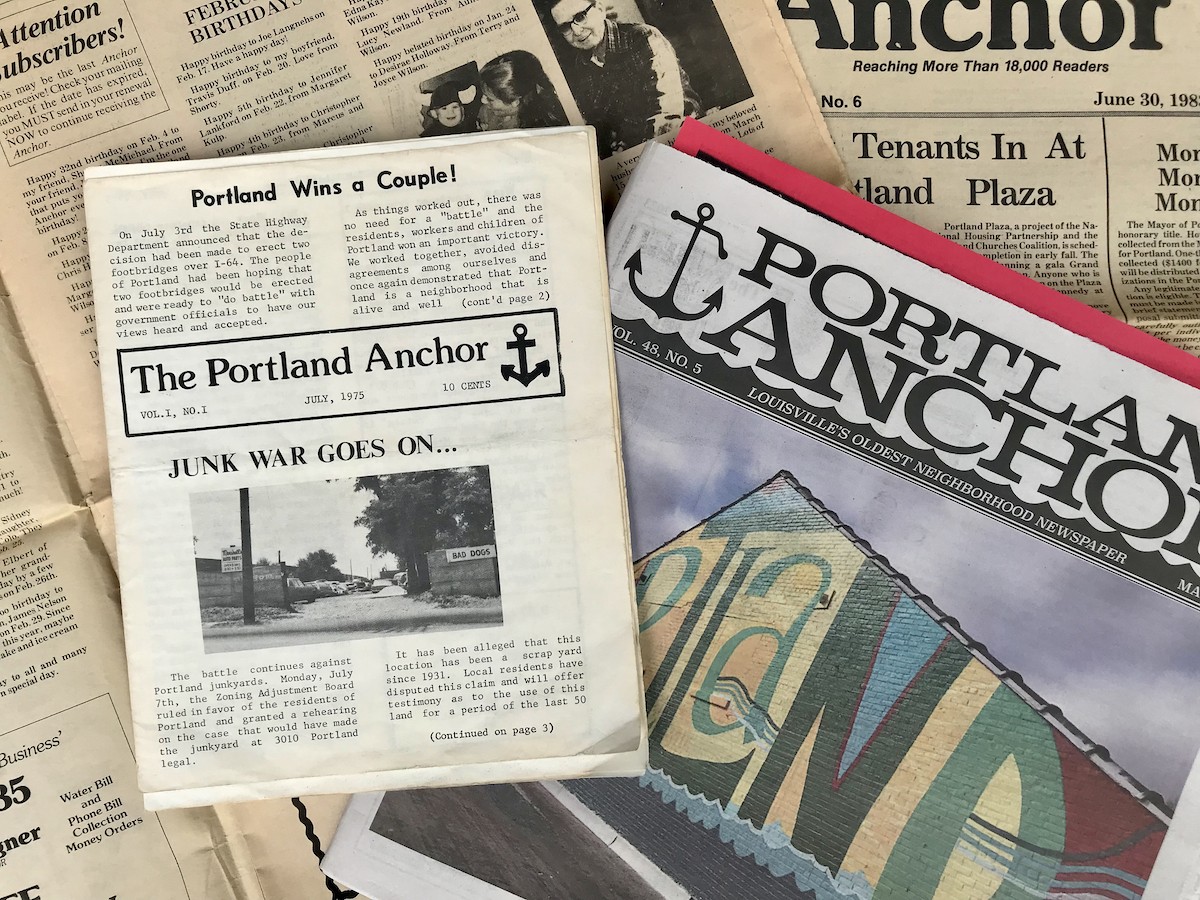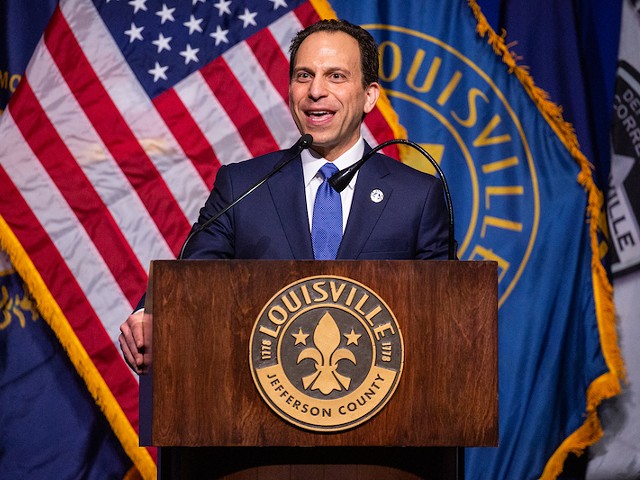Earlier this month, The Portland Anchor — a community publication in Louisville’s Portland neighborhood started in 1975 by founder Gordon Brown — moved its headquarters to Portland Museum and printed its inaugural issue. The museum’s staff and board of trustees have been entrusted under a transitioning leadership to keep the publication going.
“Our staff and board of trustees are dedicated to preserving the spirit of the newspaper with the same reverence we apply to our archives and facilities,” said Danny Seim, Portland Museum co-Director, in his recent neighborhood address, “Anchor Acquisition,” which appeared in the May issue of Portland Anchor.
The May “BIG FISH” issue (nicknamed by the Portland Museum staff) also introduced a fresh new look, “featuring color and new columns in addition to regular contributions,” according to Shannon Delahanty, Portland Museum’s creative coordinator, during recent phone and subsequent email interviews. The page count also doubled, and the pages featured original artwork from neighborhood children and professionals.
“Your quirky newspaper is new hands,” said Brown in his recent Portland Anchor editorial. “The folks who have kept the Anchor alive and doing its best to represent the interests of its readers have, not surprisingly, gotten older. Fortunately, the Portland Museum, with its own new leadership, has stepped forward to take ownership of the Portland Anchor.”
Featuring editorial ranging from community news, obituaries and advertisements from local businesses, the paper regularly publishes:
A reader-contributed “Chit Chat” column, described in the paper as “a forum to announce important family events, and to express affection and love toward family, friends and neighbors;” regular neighborhood contributions/columns from “Portland Nate,” “Grampa and Little Carmie,” and William Barnes; recipes from the Ladies of Baptist Tabernacle, and Louisville Free Public Library Portland Branch programs.
The Anchor began inside the Portland Boys & Girls Club, where in 1973, Brown previously served as citywide executive director.
“Forty-eight years ago, the first volume of the Portland Anchor Newspaper was ready to roll off the rickety, old letterpress in the basement of the Portland Boys and Girls Club,” said founder Gordon Brown in a recent editorial in the Portland Anchor. “Its creators, a group of intrepid, optimistic, and determined young Portland activists were standing by, wringing their hands, pacing the room in a worrying manner like a family awaiting the birth of a much-anticipated newborn.”
“It was our purpose to uplift the neighborhood,” said Brown in the phone interview, who was initially inspired by former U.S. President John F. Kennedy’s famous quote, “Ask not what your country can do for you — ask what you can do for your country.”
The Anchor played a role in establishing the (at the time) mostly commercially-zoned area. “We all bought into the paper,” said Brown, who worked to get [Portland] zoned to mostly residential. There is a lot of pride and strength among these people. We were starry-eyed young people with a lot of energy,” said Brown.
The group also started the Portland Summer Festival and Homecoming. Additionally, they worked to build (Portland Plaza, a housing community for the elderly).
“[Portland Plaza] is a beauty,” said Brown. “It’s still there tucked into the neighborhood. The Anchor still has a role in uplifting the neighborhood, and we are so excited with the people at the Portland Museum. It’s a happy story, said Brown. “Most people in Louisville have a lot of love for Louisville and the Portland neighborhood.”
“Brown mentored and collaborated with cohorts of children and peers in Portland who ‘believed that [they] could actually change the world,” said Portland Museum administrative coordinator William Smith in a recent Frazier Museum newsletter.
“This group included future leaders like Louisville Alderman Sharon Wilbert, banking executive Houston Cockrell, and ministry director Sue Gentry. These young adults took the Portland community seriously and tackled issues through hands-on initiatives like the Portland Anchor. Established to counteract Portland’s growing reputation from the greater city’s news media as “the cesspool of Louisville,” its debut printing was produced entirely in the Boys & Girls Club basement,” said Smith in the newsletter.
The Anchor’s impact on the Portland community since 1975 is a direct reflection of it’s “steadfast leadership,” said Seim in his “Anchor Acquisition” address. “Gordon Brown is a Louisville living legend who has transformed thousands upon thousands of young lives throughout his unparalleled career. Editor Sherry Stewart has singlehandedly pasted up or digitally assembled every issue of the Anchor for going on twenty years. Courier Charlie Frick puts a smile on everyone’s face he meets while dropping off newspaper bundles each month. These three irreplaceable people will remain at the Anchor’s helm until they decide it’s time to move on. And when they do, we are committed to sustaining their vision of our beautiful neighborhood.”
Interested in exploring the newspaper’s history a little further?
An exhibit honoring Portland Anchor’s legacy, “Anchor Management: The Magic Behind Louisville’s Oldest Neighborhood Newspaper” at the Portland Museum, 2308 Portland Ave. starting Friday, June 23. An opening reception will be held from 5-7 p.m.
“This exhibition unveils the history and significance of the Portland Anchor through a collection of archived issues, profiles on staff and contributors, and an examination of its iconic columns,” said Delahanty. “In a collage of information pulled directly from past issues, the show will weave together the community stories, editorials and photographs that have made the Portland Anchor a cherished neighborhood forum for 48 years.”
The exhibition will also feature several of Brown’s paintings, and will be the first public display of his artwork.
“We are excited to celebrate the artistic vision that helped sustain the Anchor for so long,” said Delahanty. “The Anchor is a grassroots, neighborhood initiative. For almost fifty years, it has ran on the blood, sweet, and happy-tears of volunteers and neighborhood people. For our inaugural issue, we saw the special edition paying tribute to all the long hours that came before. Taking inspiration from our ‘tried-and-true’ contributors, we sought to bring the beauty of the stories within to the surface. We hunted down a new production printer, added color printing, and brought back the full-page masthead. It was a natural way to celebrate the content that was already there — making it punchy and bright, just like the neighborhood.”
While we print over 5,500 copies and mail subscriptions all across the state, contributions ebb and flow. With the increased capacity of the Portland Museum staff, we were able to reach out to community members and make specific asks. This was less about bringing anything new to the table but more about truly reflecting the voices of our readers. It is exciting to see new entries from Young Authors Greenhouse, Farm to Fork, Western Middle, and Sterling Chase (District 5 Rep. on the YES! Youth Cabinet for Metro Lou. Government) come to the pages. Look forward to more entries from Gordon’s Corner, the Black Presence of Portland column (spearheaded by Ed White), and youth-centric contests, comics, and stories,” said Delahanty. •






